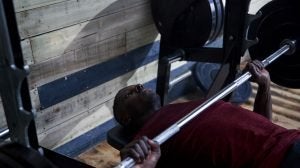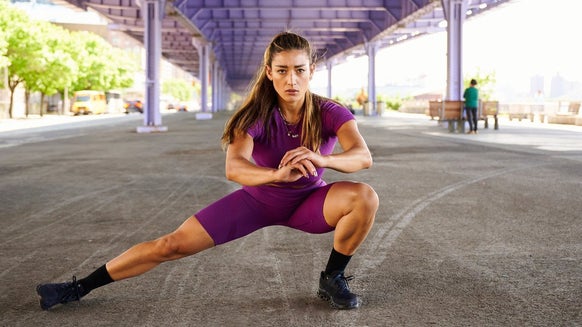
To get the most out of each exercise, Personal Trainer, Joe Nixon has broken down the exercises and given you a little bit of detail on exactly why these moves are oh-so powerful. So, whether you’re waiting for the gyms to open and looking for some inspo, or have the kit at home to try this one, it’s definitely worth a watch.
1. Laying cable side raises
The laying cable raise is a great way to isolate the deltoids, with the lateral delts getting most of the load. Resisting against a pulley mechanism allows for a smoother range of motion than when working against gravity. The delts are a small muscle, so focus should be on time under tension rather than weight.
How to
1. Lay on a bench with your head facing away from the pulley mechanism. Grip two separate cablesfrom low pulleys, at the same height you are laying at. Your hands should be at your sides.
2. Seated cable Y raises
The seated cable Y raise switches the emphasis from the lateral deltoids to the posterior (rear) delts, traps and rhomboids of the upper back; the muscles responsible for contracting the shoulder blades. Once again, this is not a compound movement and your CNS system does not get taxed, so focus on maintaining muscle tension and feeling each rep.
How to
1. Sit facing thelow-pulley mechanism, with one pulley in each hand. (It works best if the left pulley is in the right hand and vice versa).
2. Keeping your armsstiff, pull the cables up and out, finishing in a ‘T’ shape with your shoulders fully retracted and squeeze your shoulder blades together.
3. Slowly return the cables to the starting position.
3. Military press
As the one big movement of the whole workout, the military press is where the magic happens. This compound movement recruits just about the whole body. The triceps and shoulders take on the concentric efforts whilst the core, back, and even quads come into play as stabilisers and synergists. The shoulders will have pre-exhausted by cable raises and will need to work harder to complete the exercise.
How to
1. Hold a barbell just over yourcollar, with your hands at shoulder width.
2. Press it overhead. Force your head through and under the bar as it goes
3. Slowly lower thebarbell back to the starting position just above your collar.
4. Lateral raise drop-set
The lateral raise uses dumbbells to isolate the deltoids and work great as an accessory lift to use after heavy compounds. A drop-set can help get extra volume into the workout when the muscle is failing, keep intensity levels high and increase overall mechanical tension.
How to
1. Stand with a dumbbell in each handwith arms slightly bent.
3. Bringyour arms back down and bring the dumbbells back together, maintaining tension on the deltoids throughout.
5. Face pull pulses
Face pull pulses target the smaller muscles of the shoulders and place more emphasis on the rear delts, traps and rhomboids. ‘Pulsing’ is an appropriate way to hit the smaller stabiliser muscles that are vital to healthy shoulder functioning. An essential exercise to prevent injury.
How to
2. Contract your shoulder blades andbend your elbows to pull the rope to the sides of your face, keeping your elbows high.
3. ‘Pulse’ by squeezing, slightly relaxing, and squeezing again beforereturning to the starting position with arms stretched out.
6. Head supported plate rear delt fly
A variation of the rear delt fly, this exercise typically hits the rear delts but also recruits the traps and rhomboids. Having your head supported on a seated bench ensures a stable platform to perform the exercise and helps to isolate the rear delts. Can be performed with plates, dumbbells, kettlebells or just about anything.
How to
1. Bend roughly 90 degrees at the hips, keeping a stable base with your feet and supporting your forehead on a bench,box or similar implement. Hold the weight in each hand and let your arms hang towards the ground.
3. Allow your armsto slowly return to the starting position, maintaining tension throughout.
Take home message
These moves are perfect for incorporating into your return-to-gym workout plan, or trying right now if you have the kit at home. Think you could manage Marino’s HIIT session straight after? You’re braver than we are...
TRY THIS NEXT:







